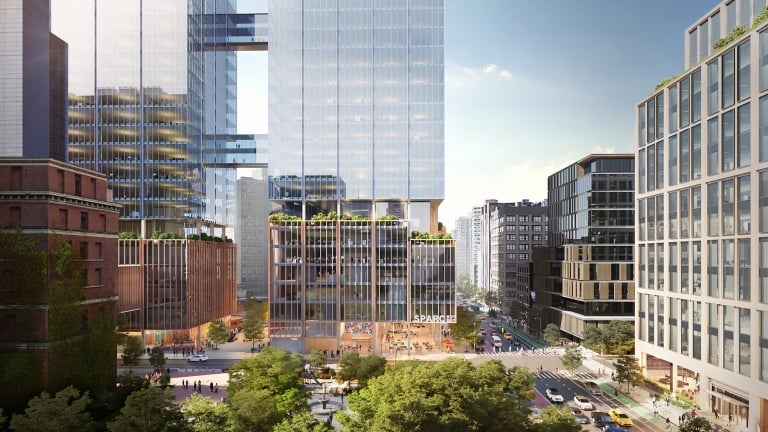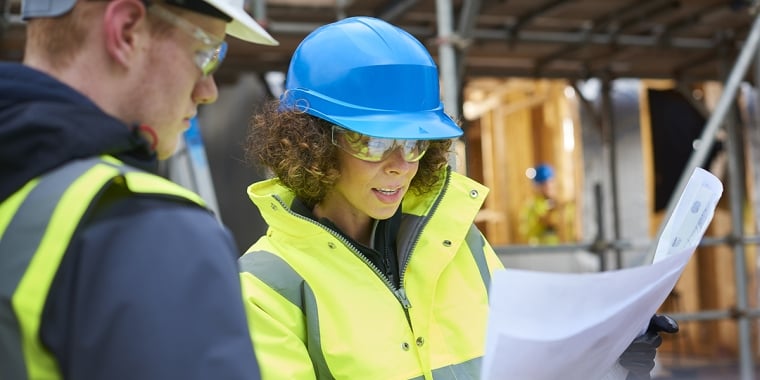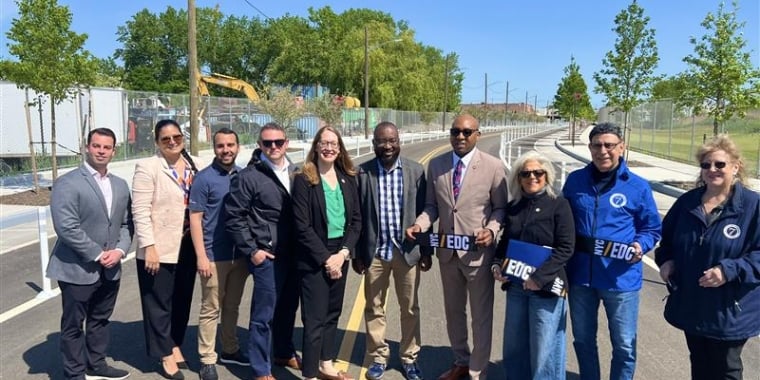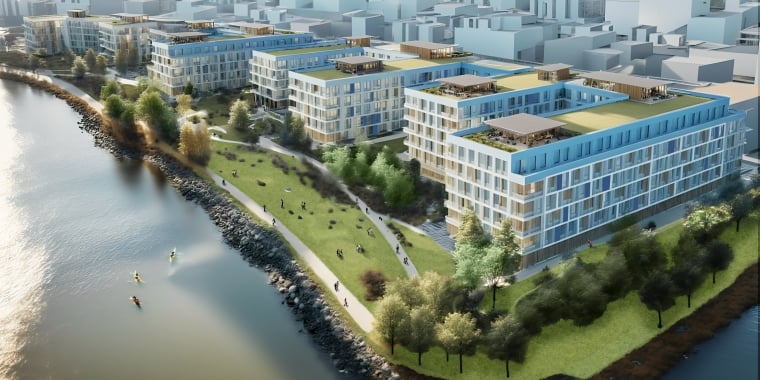Mayor Adams, NYCEDC Celebrate Historic Day for New York City Life Sciences Industry, Moving Forward Two Generational Projects in Kips Bay

SPARC Kips Bay, First-of-Its-Kind Job and Education Hub, Will Create More Than 15,000 Jobs, Generate $42 Billion in Economic Impact Over the Next 30 Years
Innovation East, Site of the Former Public Health Lab, Will Deliver a New State-of-the-Art Life Sciences Hub, Creating More Than 1,000 New Jobs
Both Projects Will Help Further Cement New York City as a Global Leader in the Life Sciences Sector, Sparking New Economic Development and Training Workforce of the Future
NEW YORK, NY—New York City Mayor Eric Adams and the New York City Economic Development Corporation (NYCEDC) today celebrated the City Council’s vote to approve the Science Park and Research Campus (SPARC) Kips Bay and Innovation East projects, as part of the Uniform Land Use Review Procedure (ULURP), signaling a historic win for New York City’s thriving life sciences industry and economy. SPARC Kips Bay, a first-of-its-kind life sciences innovation, career, and education hub is transforming an entire city block with over 2 million square feet of academic, public health, and life sciences space. First announced by Mayor Eric Adams, Governor Kathy Hochul, NYCEDC, and City University of New York (CUNY) Chancellor Félix V. Matos Rodríguez in October 2022, the historic project is expected to create more than 15,000 total jobs, generate $42 billion in economic impact over the next 30 years, and establish a pipeline from New York City’s public schools and public universities to future-forward and family-supporting careers in the life sciences and health care sectors. NYCEDC expects to start deconstruction of the campus by the end of 2025.
The Innovation East development, located at 455 First Ave, will replace the former and obsolete Public Health Lab with a new state-of-the-art life science hub. The Public Health Lab will relocate to a new, modern facility in Harlem to continue its critical work, which is expected to be complete by the end of 2025. Demolition of the existing 455 First Avenue building is anticipated to occur in 2026, with construction beginning in 2027.
The SPARC Kips Bay and Innovation East projects are key initiatives to advance the LifeSci NYC goal of creating 10 million square feet of life sciences space, creating and attracting accessible jobs in life sciences, health care, and public health, and cementing New York City as a global leader in the sector.
“SPARC Kips Bay is the exact kind of spark our city needs to ignite our economy, creating 15,000 good-paying jobs, generating $42 billion in economic impact, and leading in the emerging life sciences sector,” said New York City Mayor Eric Adams. “New York City has always been on the cutting edge and leading on the jobs of tomorrow—and SPARC Kips Bay along with Innovation East follows that great tradition and goes even further. Thank you to the elected officials who voted in favor of this project, our community partners, and all of those who want to continue to see New York City be a hub for innovation.”
“SPARC Kips Bay and Innovation East are transformative initiatives that will solidify our leadership in the life sciences sector, create thousands of jobs, and provide critical workforce training opportunities for New Yorkers,” said Governor Kathy Hochul. “Through these cutting-edge research facilities and education hubs, we are ensuring that the next generation of scientists, healthcare professionals, and innovators can build their futures right here in New York. I commend all of our partners for their commitment to advancing economic growth and strengthening our public health and biotech industries.”
“By transforming Kips Bay into a hub for cutting-edge research, education, and workforce development, we are creating thousands of good-paying jobs and establishing a strong talent pipeline that will benefit New Yorkers for generations,” said First Deputy Mayor Maria Torres-Springer. “These projects are a clear reflection of our commitment to future-proofing NYC's economy and positioning our city at the forefront of the industries that will shape the future. I want to thank Councilmembers Powers and Rivera, the entire City Council, Borough President Levine, our partners at CUNY and the State, and the dedicated team at NYCEDC for helping us reach this significant milestone.”
“Today's City Council vote is a historic milestone for the Adams' Administration's efforts to position New York City as a global leader in life sciences and healthcare, while preparing New Yorkers for the jobs of today and tomorrow,” said NYCEDC President & CEO Andrew Kimball. “The state-of-the-art projects at SPARC Kips Bay and Innovation East will not only drive significant economic impact but also create a strong talent pipeline through the city's academic institutions and organizations. NYCEDC is grateful to our City Council partners for entrusting us with this historic transformation and thanks to this monumental vote, we look forward to breaking ground on the campus in Kips Bay.”
“The life sciences sector is a driving force for job creation and economic growth in New York, and the SPARC Kips Bay and Innovation East projects will take this industry to new heights,” said Empire State Development President, CEO, and Commissioner Hope Knight. “These developments will not only generate thousands of jobs but also build a direct talent pipeline from our city’s public schools and universities to careers in healthcare, biotechnology, and scientific research. These initiatives will further position New York as a global hub for life sciences innovation.”
“The City Council’s approval of SPARC Kips Bay marks a crucial step in bringing this transformational hub to life,” said CUNY Chancellor Félix V. Matos Rodríguez. “The research campus will expand CUNY’s ability to support our city and train the health care workforce that will keep New Yorkers healthy for decades to come. Our University is proud to be a key partner in adding the life sciences to the list of worldwide industries that have their center right here in New York.”
SPARC Kips Bay
A truly generational and first-of-its-kind project, SPARC Kips Bay is expected to generate approximately $42 billion in economic impact over the next 30 years, create over 15,000 jobs, including 12,000 union construction jobs and 3,100 permanent jobs in the life sciences sector, and transform Hunter College’s Brookdale Campus on East 25th Street and First Avenue into new, state-of-the-art academic and life science facilities. The project also achieves long-standing community priorities with over 1.5 acres of public realm improvements, including the creation of new publicly accessible open space, and a new ADA accessible 25th Street pedestrian bridge over the FDR Drive.
The campus will include clinical classrooms and teaching labs across three integrated CUNY schools—Hunter College School of Nursing, CUNY Graduate School of Public Health & Health Policy, and Borough of Manhattan Community College health care programs; a NYC Public Schools (NYCPS) health and science-focused high school and STEAM center; outpatient ambulatory care services and a training simulation center for NYC Health + Hospitals (H+H); a new forensic pathology center and medical examiner facility for the Office of the Chief Medical Examiner (OCME); life sciences research labs for companies of all sizes; and community and retail spaces.
ULURP approval is a significant milestone for this historic project, building upon:
- In November 2023, Mayor Adams and Governor Hochul unveiled the SPARC Kips Bay Master Plan. The master plan outlines key project details, including a new site plan and conceptual design, a new model for education and job training pipelines, and public health by creating a pipeline from local public schools to careers in these essential sectors.
- In April 2024, after a competitive RFP process, Ennead and Dattner Architects was selected to complete the design of the project’s first phase, including SPARC Square and other public realm improvements, over 600,000 square feet of educational facilities for the CUNY and New York City Public Schools, flood protection measures, and a new ADA accessible pedestrian bridge.
- In January 2024, NYCEDC launched the SPARC Kips Bay Community Task Force, co-chaired by Councilmember Keith Powers and the CB6 Chair. The Community Task Force developed a set of Community Design Principles that inform the design of the future campus and its integration into the surrounding community. The Principles were released in June 2024, and will be appended to the future Life Sciences Developer RFP.
- In March 2024, NYCEDC assembled the Kips Bay Science District (KBSD) Education and Workforce Task Force—a collective of nearly 50 leaders in education, workforce, and industry devoted to ensuring Kips Bay provides equitable access for New Yorkers to the city’s health and life sciences education, training, and job opportunities.
- In January 2025, NYCEDC and the Task Force released a report, “Empowering Kips Bay’s Future Workforce: The Kips Bay Science District Education & Workforce Vision,” which puts forth four key recommendations to support its mission by developing sector-specific career pathways, programs and partnerships within Kips Bay.
- In February 2024, NYCEDC announced a Request of Expressions of Interest (RFEI) to source a world-class tenant who will establish and operate a cutting-edge life sciences center at SPARC Kips Bay. NYCEDC anticipates allocating up to $100 million of city capital to support the development of this innovation center. This center can include a translational research institute, corporate innovation campus, non-profit or philanthropy led research entity, and an innovation hub or accelerator, among other opportunities. NYCEDC anticipates announcing the selection in the spring.
- In June 2024, NYCEDC released a Request for Proposal (RFP) for a construction management firm to manage the construction of the first phase of the project. Last September, NYCEDC announced Skanska as the construction manager to oversee the first phase, following the RFP released earlier in the year. The total anticipated contract award is expected to be over $1 billion, and the work will be governed under a Project Labor Agreement (PLA). Construction is expected to begin at the end of 2025 and is anticipated to be completed in 2031.
- As part of New York City’s Green Economy Action Plan, NYCEDC announced SPARC Kips Bay will implement the Clean and Circular: Design and Construction Guidelines. The guidelines promote reducing embodied carbon, deconstructing buildings in lieu of demolition, and reusing or recycling existing materials. By using innovative circular construction methods on this phase of the project, SPARC Kips Bay is anticipated to reduce carbon emissions in comparison to a traditional building project. This project will serve as an example in circular construction for other large public and private projects.
- The first recommendation in the “Empowering Kips Bay’s Future Workforce: The Kips Bay Science District Education & Workforce Vision” is “Scale and fund exposure-based learning opportunities for talent in the district.” Acting on this recommendation, NYCEDC will support new science educational programming for K-8th grade students in Kips Bay, connecting local students to compelling science content. NYCEDC will procure one or several educational providers of science education who will coordinate with priority schools identified by Council Member Powers (PS40, PS116, PS281, PS59, MS255 and MS104) to deliver life sciences curriculum and educational programming starting with school year 2025/2026, reaching more than 3,200 elementary and middle school students annually for five years.
NYCEDC is anticipating releasing an RFP seeking developers to build one million square feet of life sciences space and modern facilities for H+H and OCME as part of SPARC’s second phase. Additionally, NYCEDC will deliver phase one of the project on behalf of CUNY, NYCPS, NYC School Construction Authority, and the City, along with new community infrastructure—including SPARC Square, the new 25th Street pedestrian bridge, streetscape improvements and floodwall tie-in.
Innovation East
Innovation East, located at 455 1st Avenue, will transform the former Public Health Laboratory site, which is being rebuilt at Harlem Hospital, into a state-of-the-art life sciences hub, helping to foster a vibrant research ecosystem in the Kips Bay neighborhood. The new 500,000 square foot Innovation east development will also provide a range of benefits to the community. The project has the potential to create more than 1,000 jobs across skills and education levels, including life sciences jobs, business managers, administrative assistants, and building service workers. The facility will also include partnerships with local K-12 schools, colleges, and nonprofits to build access to career pathways in the life sciences sector, including hands-on educational opportunities for K-12 students; internships and networking opportunities for college students; and job training and recruitment opportunities for residents and the community.
“Our partnership is honored to receive City Council approval for Innovation East,” said Taconic President and Chief Operating Officer Colleen Wenke, on behalf of the Innovation East partnership (455 First Avenue Associates). “We thoughtfully conceived this project in response to the City’s 2018 RFEI and look forward to our ongoing collaboration with the development's many community, educational, and workforce stakeholders to advance the evolution of the Kips Bay Health and Science Corridor. Innovation East brings to fruition the visionary work of three Mayoral administrations and the outstanding Economic Development Corporation team to continue to make New York City a national leader in the life sciences. We are extremely grateful for the support of our labor union partners, Manhattan Community Board 6, Manhattan Borough President Mark Levine, Council Member Carlina Rivera, and New York City Council.”
“I applaud the approval of SPARC Kips Bay and Innovation East projects by the City Council today, a testament to the need for this innovative project that will bring cutting edge life sciences research in the heart of the East Side,” said Congressman Jerry Nadler. “I look forward to seeing progress on this project that will add green and pedestrian spaces alongside new world-class research facilities for the community.”
“Today’s vote at City Council is an exciting milestone for SPARC and Innovation East, two projects that will position New York City as a leader in life sciences, provide 16,000 jobs, create academic opportunities for New Yorkers, and make crucial improvements to the public realm,” said Manhattan Borough President Mark Levine. “With the public review process complete, we are a huge step closer to making these transformative projects a reality.”
“Today’s vote to advance SPARC Kips Bay is a huge step forward in making New York City a destination for the life sciences industry,” said New York City Councilmember Keith Powers. “Science and technology are the future, and we must prepare our young people to have jobs in these growing fields. With SPARC, we are building educational opportunities starting in 3k and going all the way to post-doc, providing hands-on training for students, and a pipeline to highly skilled jobs in cutting edge industries. I am proud to have advocated for this project to be integrated into the surrounding community of Kips Bay with crucial infrastructure and public realm improvements, as well as additional 3k public school seats for the next generation of New Yorkers.”
“Innovation East and SPARC Kips Bay are transformative projects that will strengthen New York City’s position as a global leader in life sciences while delivering meaningful benefits to our community,” said New York City Councilmember Carlina Rivera. “These state-of-the-art facilities will not only create tens of thousands of new jobs, but also provide educational and workforce development opportunities for local residents and students. Through partnerships with community organizations and investments in public spaces, we are ensuring that this development enhances the entire neighborhood. I am grateful to NYCEDC, the development team, and Community Board 6 for working collaboratively to make this vision a reality.”
“Manhattan Community Board Six (CB6) congratulates NYCEDC and the SPARC Kips Bay and Innovation East project teams on this significant achievement,” said Manhattan Community Board Six Chair Sandra McKee. “As these projects proceed, CB6 will continue to follow them closely and advocate for our community so that SPARC Kips Bay and Innovation East develop into resources that benefit and are valued by our community.”
“Today's SPARC and Innovation East approval isn't just a win for New York City's life sciences sector, it's a victory for union workers and their families,” said Gary LaBarbera, president, Building & Construction Trades Council of Greater New York. “With over 12,000 union jobs expected during the construction of this transformative new campus, SPARC and Innovation East will be supporting skilled workers from the local community and helping them build strong careers in the building and construction trades. We're thankful for the Mayor and Governor's commitment to union labor, and we're excited to get to work on both SPARC and Innovation East and so many other projects throughout this city.”
“SPARC Kips Bay and Innovation East mark a transformative investment in the future of Manhattan’s East Side—unlocking thousands of high-wage jobs, expanding the life sciences sector, and creating economic mobility for New Yorkers,” said New York City Employment and Training Coalition (NYCETC) CEO Gregory J. Morris. “These hubs will anchor a growing innovation corridor in Kips Bay, connecting education, workforce training, and employers to open career pathways in life sciences and healthcare. This is especially critical for New Yorkers from historically underrepresented backgrounds, who will gain the skills and access needed to thrive in these fast-growing industries. NYCETC is committed to ensuring NYC's evolution into a life sciences and healthcare powerhouse that translates into opportunity for all.”
The New York City Charter requires certain actions that are reviewed by the City Planning Commission to undergo ULURP. ULURP is a standardized procedure whereby applications affecting the land use of the city are publicly reviewed. The Charter also mandates time frames within which application review must take place. Key participants in the ULURP process are the Department of City Planning (DCP) and the City Planning Commission, Community Boards, the Borough Presidents, the Borough Boards, the City Council, and the Mayor.
About NYCEDC
New York City Economic Development Corporation is a mission-driven, nonprofit organization that works for a vibrant, inclusive, and globally competitive economy for all New Yorkers. We take a comprehensive approach, through four main strategies: strengthen confidence in NYC as a great place to do business; grow innovative sectors with a focus on equity; build neighborhoods as places to live, learn, work, and play; and deliver sustainable infrastructure for communities and the city's future economy. To learn more about what we do, visit us on Facebook, Twitter, LinkedIn, and Instagram.


